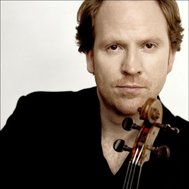 Violinist Daniel Hope.
Violinist Daniel Hope. However, on Thursday evening, at Toronto’s Koerner Hall – where violinist Daniel Hope and pianist Sebastian Knauer played a recital – the musicians candidly stated from the stage that, having just flown in from Europe, it felt to them like three o’clock in the morning.
The recital program was intended as a tribute to Yehudi Menuhin, who would turn 100 this year, were he still living.
Menuhin and Hope had an especially close relationship. Hope first encountered Menuhin at the tender age of two, when his mother accepted a position as the great virtuoso’s personal assistant. When Hope was 16, Menuhin became his teacher, mentor and colleague. They toured together until Menuhin’s death in 1999 – and Hope’s remarks from the stage made it clear that Menuhin’s passing was a great artistic and personal loss for him.
For this program, Hope selected works that were closely associated with Menuhin in some way, beginning with Bach’s Sonata No. 4 in C Minor. Unfortunately, in the first movement, Knauer’s playing was so soft and delicate that Hope’s interpretation had no firm foundation to stand on. For this reason the duo sounded flimsy and not always quite together. Things soon improved, I’m glad to say, with a stronger showing from Knauer, and a surer sense of ensemble and direction from both musicians.
George Enescu’s Impromptu concertante wasn’t consistently good, either. This is complex music, requiring unity and clarity to succeed. What we heard sounded more like a confused competition between violin and piano.
In the first movement of Mendelssohn’s Violin Sonata in F Major (which Menuhin helped into print in 1953), rapport between Hope and Knauer proved frustratingly elusive. However, the rest of the sonata was an entirely different story, with the violinist and pianist finding their way to the same page. The second movement was taut and effectively phrased. And the third movement was even better: lively and exciting, but with a charming attention to detail.
The duo’s new-found cohesion was well displayed in Bartók’s Romanian Folk Dances. Here, Hope’s tone – smooth and refined, up to this point in the evening – was stylishly gutsy and rough hewn. Also impressive was Ravel’s Kaddisch. Hope’s tone soared, in rich, long lines.
There were also plenty of big, sweeping phrases in the first movement of Walton’s Violin Sonata (which was written for Menuhin). And although I can’t say I entirely share Hope’s enthusiasm for the piece, I enjoyed his introspective ruminations and his soaring flights to the stratosphere. The second movement was eerie and brilliantly chilling, with just a touch of edgy harshness. It was vivid playing.
And there we have it: an uneven program that was partially – and only partially – up to the standards one would expect from an artist of Hope’s stature.
I see that Hope will soon play the same program in New York. I trust that he and his accompanist will get plenty of rest beforehand.
© Colin Eatock 2016
 RSS Feed
RSS Feed

